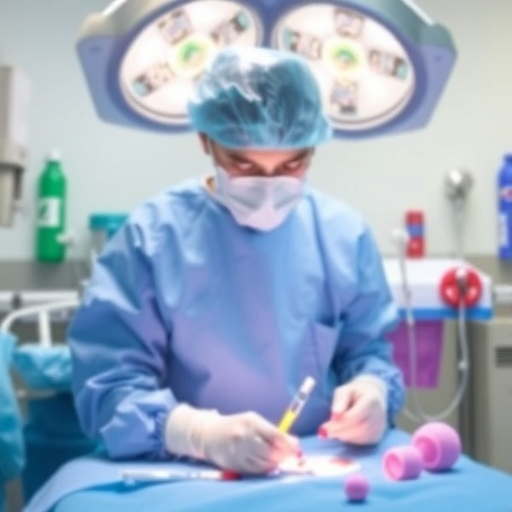In recent years, the medical community has taken significant strides in understanding the impact of various preoperative biomarkers on patient outcomes. A notable study by Liu, Gou, and Yang delves into the preoperative neutrophil-to-lymphocyte ratio (NLR) and its correlation with postoperative length of stay in pediatric patients undergoing laparoscopic appendectomy. This research has the potential to change how surgeons approach the scheduling and management of pediatric surgical cases.
The study emphasizes the significance of the NLR, a simple and cost-effective laboratory measure, which can provide insights into the body’s inflammatory response. High levels of neutrophils, coupled with a decrease in lymphocytes, often indicate an underlying inflammatory process. Such immune responses are crucial, especially in surgical patients, as they could influence recovery periods and postoperative complications.
In conducting this retrospective cohort study, the researchers analyzed a large patient pool, enabling them to uncover vital data about the relationship between NLR and surgical outcomes. The comprehensive methodology employed allowed the researchers to control for several confounding variables, such as age, sex, and underlying health conditions, thereby enhancing the reliability of their findings.
One of the key discoveries was that pediatric patients with elevated NLR levels before undergoing laparoscopic appendectomy had longer lengths of stay in the hospital compared to those with normal NLR values. This correlation suggests that increased inflammatory activity may prolong recovery times, highlighting the need for enhanced perioperative management in this demographic.
The implications of this research are vast, especially in guiding preoperative assessments and postoperative care. Surgeons could potentially utilize NLR as a predictive tool, allowing for the identification of high-risk patients who may benefit from more intensive monitoring or intervention strategies. This could lead to optimized care pathways and improved overall outcomes for young patients.
Further examination of the data revealed that the relationship between NLR and hospital stay duration was not isolated to appendectomies alone. It raised a broader question regarding the use of inflammatory markers across various types of surgeries in pediatric patients. Understanding these relationships could pave the way for more individualized and effective treatment plans tailored to each child’s unique health profile.
Moreover, this research underscores the growing recognition of the immune system’s role in surgical recovery dynamics. It emphasizes the need to explore other biomarkers that may be indicative of inflammation or immune status, offering a more holistic view of patient readiness for surgery.
As we continue to uncover the complexities of the immune response in surgical contexts, the findings from Liu, Gou, and Yang could serve as a springboard for further studies. Further exploration into the implications of NLR could facilitate the identification of critical thresholds that inform clinical decision-making, particularly in pediatric surgery.
In light of these findings, medical professionals are encouraged to consider the NLR not only as a standalone marker but as part of a more comprehensive evaluation. By integrating various biomarkers and clinical assessments, healthcare providers can enhance their predictive capabilities, ultimately leading to a reduction in unnecessary hospital stays and a more efficient use of medical resources.
As the medical community embraces such evidence-based practices, the insights gained from this study could lead to paradigm shifts in how pediatric surgical patients are managed preoperatively and postoperatively. The adaptation of findings into clinical settings could also enhance multi-disciplinary care approaches, ensuring that all healthcare providers are aligned in their understanding of the implications of inflammatory markers.
In conclusion, the study by Liu, Gou, and Yang provides a significant contribution to our understanding of surgical outcomes in pediatric patients. By highlighting the association between preoperative NLR and length of hospital stay, it opens the door to more precise, data-driven approaches in pediatric surgical care. This research not only elucidates the role of inflammation in surgical recovery but also highlights the necessity for ongoing investigations into the myriad factors that influence patient outcomes.
In taking these findings forward, we must advocate for further research into the predictive value of NLR across not just surgical procedures but also diverse medical conditions and treatment modalities. This research could ultimately redefine standards of care, emphasizing a more personalized approach tailored to the specific needs of pediatric patients.
As we look forward to the implications of such findings, it becomes increasingly clear that understanding the interplay between inflammation and recovery is not just a matter of academic interest but is crucial for the future of pediatric medicine.
Subject of Research: Association between preoperative neutrophil-to-lymphocyte ratio and length of stay in pediatric patients undergoing laparoscopic appendectomy.
Article Title: Association between preoperative neutrophil-to-lymphocyte ratio and length of stay in pediatric patients undergoing laparoscopic appendectomy: a retrospective cohort study.
Article References: Liu, M., Gou, Y. & Yang, P. Association between preoperative neutrophil-to-lymphocyte ratio and length of stay in pediatric patients undergoing laparoscopic appendectomy: a retrospective cohort study. BMC Pediatr 25, 668 (2025). https://doi.org/10.1186/s12887-025-06043-3
Image Credits: AI Generated
DOI:
Keywords: preoperative neutrophil-to-lymphocyte ratio, pediatric surgery, laparoscopic appendectomy, length of stay, inflammatory response, postoperative care, healthcare outcomes.




